Lehn & Fink
Frederick William Fink was born in Cassel, Hesse, Germany in 1946. In 1860, his family moved to Fulda where entered the drug and chemical trade but when Prussia annexed Hesse-Cassel in 1866, Frederick decided to emigrate to America. He arrived in New York in 1867 and settled there, gaining employment with Elmer & Amend, a New York drug firm.
Frederick wanted to go into business for himself but did not have the funds. When Louis Lehn [1838-1915] and an unknown third party said they would back him, he formed the partnership of Lehn & Fink and used the US$30,000 he had at his disposal to set up an office and warehouse in a sale loft in a building at 160 William Street in lower Manhattan. On May 1st, 1874, the business opened and for the first six months Frederick Fink was its only salesman. As the business grew others were employed. In 1884, the firm relocated to a new and much larger building at 128 William Street, New York by which time sales had reached US$500,000 per year (Farrell, 1949, p. 686).
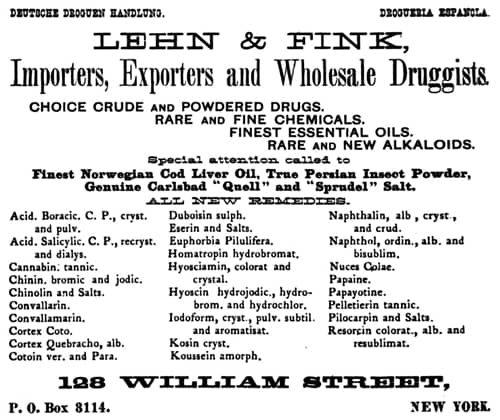
Above: 1884 Some products sold by Lehn & Fink.
By 1884, a number of individuals who were to play a part in the history of Lehn & Fink – Albert Plaut, William J. Gesell [1865-1922] and Robert R. Lampa [1863-1935] – had joined the firm. In 1886, when Louis Lehn retired, Albert Plaut bought his interest and became a partner. Albert also introduced his brother, Joseph Plaut, into the firm who then became its financial manager.
Lysol
In 1889, Frederick Fink attended the Paris Exposition and while in Europe made a number of business agreements. Perhaps the most important of these was the rights to a new water-soluble disinfectant called Lysol, developed by Dr. Gustav Raupenstrauch [1859-1943]. Initially, Lehn & Fink imported Lysol in 100 gram and 500 gram bottles from the Hamburg manufacturer Schülke and Mayr but as sales increased they began buying it by the barrel and bottling it themselves.
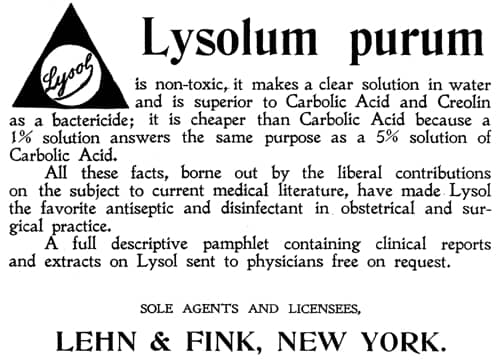
Above: 1896 Lysolum purum.
In the first instance, Lysol was only sold to physicians. However, in 1912, Lehn & Fink entered into an agreement with Schülke and Mayr for the rights to manufacture Lysol in the United States. Soon afterwards they began selling Lysol as a general household disinfectant even though not everyone thought this was a good idea.
I see Lehn & Fink are like the majority of non-ethical firms. After they get the doctor to using their line, like lysol and purgen, they begin advertising to the laity. See their ‘ad’ in the Ladies Home Journal (past two or three months). In a lot of states and in Germany this is classed as a poison with carbolic acid, etc., and has to be registered for in the same way. I think the Journal A.M.A. and all ethical journals should make a kick about this, not only on the grounds of the non-ethical way of advertising but also on the ground that it is too poisonous a product to advertise to the public. I am surprised that the Ladies Home Journal will permit it.
(Editorial Note, 1913, p. 135)
The editor’s fears were not groundless. After 1912, Lysol was often drunk by individuals trying to commit suicide.
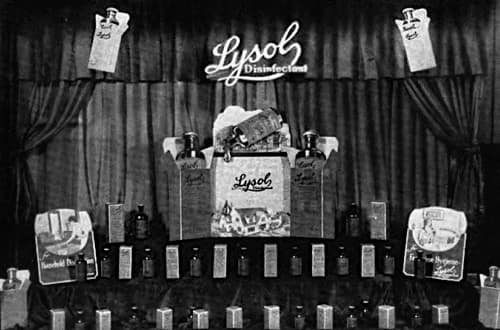
Above: Lysol window display in the entrance lobby of 635 Greenwich Street.
Lysol was so important to Lehn & Fink that they bought Schülke and Mayr and Lysol Ltd. (London) in 1919, and then the makers of Marshall’s Lysol in the United Kingdom in 1926.
Pebeco
A second product of importance to the company was Pebeco toothpaste. Developed by Dr. Paul G. Unna [1850-1929] of Hamburg, it was sold as a powder and cream by P. Beiersdorf & Co., of Hamburg, Germany. Lehn & Fink had been importing Beiersdorf’s plasters and salves so it had an established relationship with them. In 1903, they acquired a license to manufacture Pebeco in the United States using some ingredients imported from Germany and by 1914 Pebeco was one of the best-selling toothpaste brands in America. Unfortunately, when ingredient supplies were cut off during the first World War, the quality of the product suffered and, when combined with the growing animosity to everything German, Pebeco’s market position began to slip.
In 1919, Lehn & Fink paid US$1,000,000 to the Office of Alien Property Custodian – set up in 1917 after the United States entered the War – for the Pebeco formula, trade-mark and goodwill. Lehn & Fink then stopped paying royalties to Beiersdorf and this soured the relationship between the two companies. After a decade of litigation American courts eventually restored Pebeco to Beiersdorf but by then Pebeco’s position in the American market was even weaker.
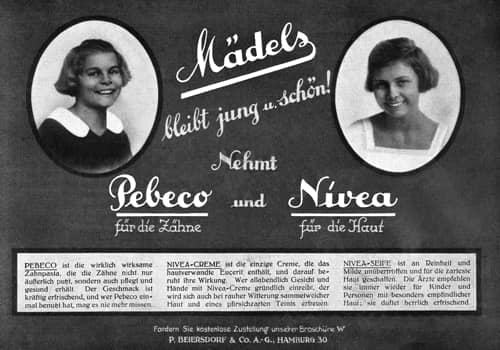
Above: 1926 Pebeco and Nivea. By this time the relationship between Lehn & Fink and P. Beiersdorf & Co. AG had deteriorated. In 1914, Beiersdorf contracted Lehn & Fink with the U.S. rights to the Nivea trademark and a license to manufacture Nivea products for the American market but by 1929 Lehn & Fink were no longer making or selling Nivea.
Incorporation
In 1898, Frederick Fink retired and sold his stake in Lehn & Fink to Albert and Joseph Plaut, giving the two brothers control of the business. In 1910, they converted Lehn & Fink into a company and then incorporated it with a capital of US$600,000 in 1916. Albert Plaut was elected company president and Joseph Plaut was made its treasurer. When Albert Plaut unexpectedly died in 1915, Joseph became company president and his son, Edward Plaut joined the business. Edward became president of the company in 1921.
In January, 1901, a disastrous fire left the company homeless. The company was covered by insurance and a new seven-storey building was constructed on an L-shaped site bordering William and John Streets, New York. Late in 1901, Lehn & Fink moved into 120 William Street from their temporary accomodation in Beekham Street. By 1902, seven floors of the building had been expanded into 79 John Street.
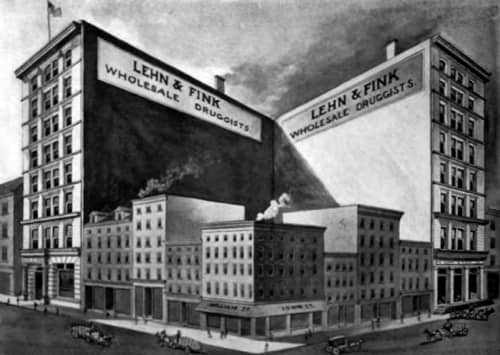
Above: 1902 Lehn & Fink at 120 William Street and 79 John Street. The buildings were sold in 1919.
Lehn & Fink remained at William and John Streets until 1920 when they moved to a new site at 635 Greenwich Street, New York, bordering Greenwich and Morton Streets.
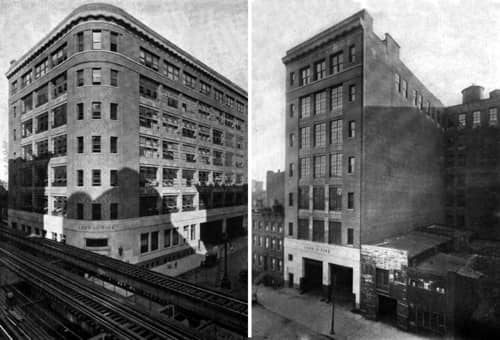
Above: 1921 The New York office and warehouse of Lehn & Fink designed by Buchman & Kahn and constructed by G. Richard Davies, Inc. Building front on the corner of Morton and Greenwich Streets (left) and rear on Barrow Street (right). The entire ground floor was devoted to shipping.
In 1918, Lehn & Fink commissioned a six-storey addition to their factory on 85 Sedgwick Street, Brooklyn but two years later, in 1920, the company developed a new factory on a large site at 192 Bloomfield Avenue, Bloomfield, New Jersey. Facilities were expanded to cope with the growing business and by 1925 there were seven buildings on the site.
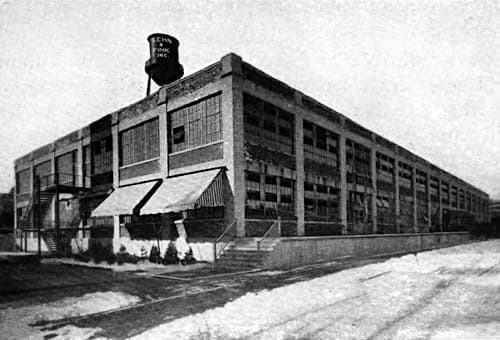
Above: Lehn & Fink plant at Bloomfield, New Jersey also designed by Buchman & Kahn. Pebeco and Lysol branded products were manufactured here.
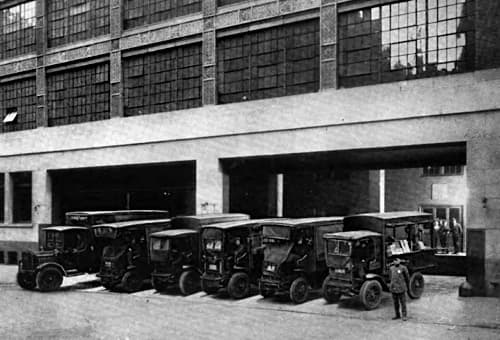
Above: Delivery trucks at the Lehn & Fink plant in Bloomfield.
As the company expanded, two American subsidiaries were created. In 1920, Lysol, Inc. was incorporated in the United States and then, in 1924, a second American subsidiary, Pebeco, Inc., was established.
Change of direction
In 1925, an audit of the business found that profits from Pebeco toothpaste, Lysol disinfectant and other trade-marked products exceeded those of Lehn & Fink’s other interests. As a result, the company stopped manufacturing general pharmaceuticals and abandoned its wholesale drug business. From then on Lehn & Fink concentrated on making proprietary products and, as part of this new business model, began acquiring established cosmetics and toiletries brands. The company had some familiarity with cosmetics as they had been selling a number of lines for a decade or more.
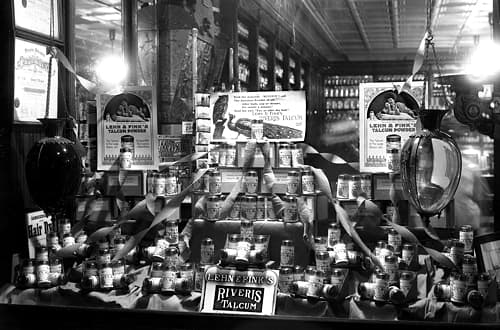
Above: Drug store window display of Riveris Talcum Powder.
Henna-San: “Changes any colored hair to any desired shade of auburn. Always produces satisfactory results. It is all vegetable, so cannot affect the health of hair, scalp or body.”
Thespis Cold Cream: “A superfine product and a perfect cleanser. Has a great demand from theatrical and everyday folk.”
Riveris Talcum Powder: “Scented with the essence of Riviera violets. A fine powder of the highest class, and for a number of years a steady, fast and an ever-growing seller.”
Poudre De Riz: “A violet-perfumed rice powder which is free from all adulteration. Very fine grain. A great favorite among those whose preference is for rice powders.”
In 1925, Lehn & fink made its first major cosmetics acquisition, the A. S. Hinds Company of Portland, Maine, makers of Hinds’ Honey and Almond Cream. To facilitate the purchase a new holding company, Lehn & Fink Products Co., was established. It acquired all the stock of A. S. Hinds Co. – at a net cost of just over US$5.3 million – as well as that of Lehn & Fink, Inc. This purchase was followed by Dorothy Gray (1927), a large New York cosmetics company, and Lesquendieu, Inc. (1929), which imported Lesquendieu cosmetics and perfumes into America from France. Lehn & Fink would go on to sell Lesquendieu products under the Tussy brand.
See also: A. S. Hinds, Dorothy Gray and Lesquendieu
Like Lysol, Inc. and Pebeco, Inc., these new subsidiaries were kept as separate companies even though most of the local manufacturing took place at the Lehn & Fink factory in Bloomfield, New Jersey.
Emil G. Klarmann
In 1924, the company employed Emil G. Klarmann as a research chemist. As well as being involved in the production of new cosmetics for Lehn & Fink subsidiaries, Klarmann was also instrumental in the development of the first chemical sunscreen containing benzyl salicylate and benzyl cinnamate (1928); Formula L-F Lysol (1931); Etiquet deodorants (1942); Amphyl and O-Syl professional disinfectants (1948); the introduction of Peb-Ammo Tooth Powder (1949) an ammoniated tooth powder licensed from the University of Illinois Foundation; and a less toxic Lysol (1952).
Etiquet
Etiquet deodorant was originally made as a cream and sold in a glass jar but it became available in a tube in 1949. The active ingredient appears to have been hexachlorophene but antiperspirant forms were later made using aluminium sulphate. Other additions to the line included: Etiquet Spray-on deodorant (1950), sold in a puff pack similar to the one developed for Stopette; Etiquet Rolit deodorant (1957), a roll-on; and Etiquet Pink Stick (1957). Perhaps to make them appear more feminine, when Pink Stick was added, the cream and spray forms of Etiquet were renamed Pink Cream and Pink Spray respectively.
See also: Hexachlorophene and Stopette
Amalgamation
In 1934, inter-company dividends became subject to taxation in the United States and this seems to have triggered changes in the way Lehn & Fink structured its businesses. In 1936, the Lehn & Fink Products Company took over the assets and businesses of Pebeco, Inc. and A. S. Hinds and both of these businesses were then dissolved. The Lehn & Fink Products Company and Lehn & Fink, Inc. were then merged into Lysol, Inc. which subsequently changed its name to the Lehn & Fink Products Corporation.
War
Sales of Lehn & Fink cosmetics and toiletries in the United States suffered during the Second World War but the reduced earnings from this source were offset by increased sales of disinfectants for personal and military use, and by the manufacture of munitions for the American army. The company’s chief engineer, George Walter Dunnican [1897-1973], developed a safer and cheaper fuse for anti-tank mines and Lehn & Fink was given a contract to manufacture them. Millions of these fuses were made and by 1943 about one-third of Lehn & Fink’s workers were making ordinance.
Post-war
When the war came to an end, Lehn & Fink bought their British affiliate, Lysol Ltd. (London) as well as Schülke & Mayr which gave them the worldwide rights for Lysol. In the United States the company needed more space for expansion so, in 1947, Lehn & Fink took out a long-term lease on a factory in Lincoln, Illinois.
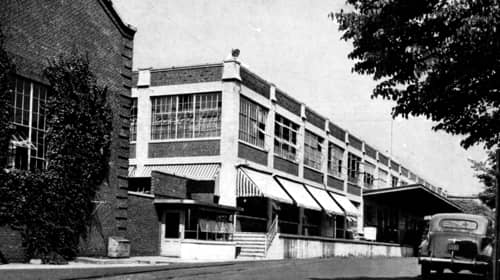
Above: 1949 The Lehn & Fink plant at Bloomfield, New Jersey. The property was sold in 1964 but Lehn & Fink continued to lease some office and research space there up until the company was merged with Stirling Drug in 1968.
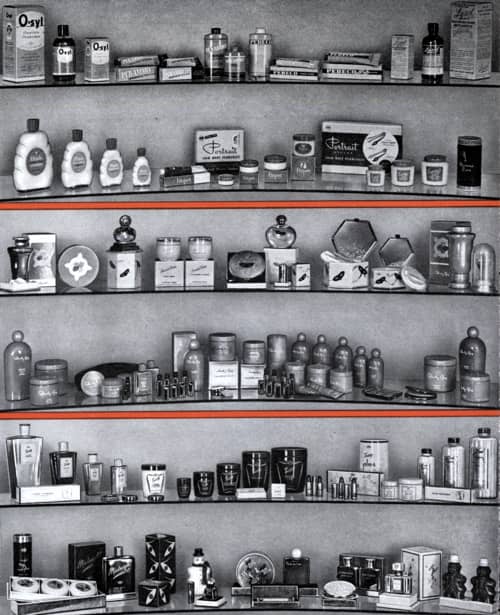
Above: 1949 Lehn & Fink products.
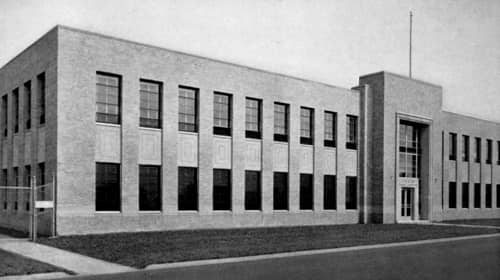
Above: 1949 Lehn & Fink plant at Lincoln, Illinois designed and constructed by the B-W Construction Company of Chicago.
The company also moved its New York offices. In 1947, the company moved from the Dorothy Gray building at 683 Fifth Avenue to the newly constructed Universal Pictures Building at 445 Park Avenue. Space for a Dorothy Gray salon was included in the leasing arrangements.
Issues
Lehn & Fink faced a number of problems in the post-war environment but three are of particular importance.
Hair-care: Home permanents and home hair-colouring kits were popular products in the post-war period. Lehn & Fink did not have a well-developed range of hair-care products and began buying existing companies to cover the gaps in its product lines. Its acquisitions included: the H. H. Tanner Company of St. Paul, Minnesota (1948), which made home permanent cold wave kits under the trade name Portrait; The Ogilvie Sisters (1956), a well-established New York firm; and Noreen, Inc. (1960), the makers of Liquid Color Hair Rinse and La Viola Hand Cream.
Lehn & Fink products group: After the war, the company added a number of products to its Lehn & Fink group of products including: O-Syl and Amphyl disinfectants (1948); and Peb-Ammo toothpaste and powder (1939), an ammoniated tooth dentrifice. In 1952, the company created a new form of Lysol that could be sold as non-poisonous in the United States. Made with ortho-hydroxydiphenyl rather than cresol, this greatly reduced Lysol’s toxicity and may have formed the basis for Lysette (1959), a liquid douche aimed at younger women.
Other products in this group included: Hinds Honey & Almond Fragrance Cream; Portrait Home Permanents; Henna San hair lightener; and Etiquet deodorants. Unfortunately, many of these products showed little or no growth and sales for the group as a whole stagnated. This situation would not change until 1962 when Lysol Spray was put on the market.
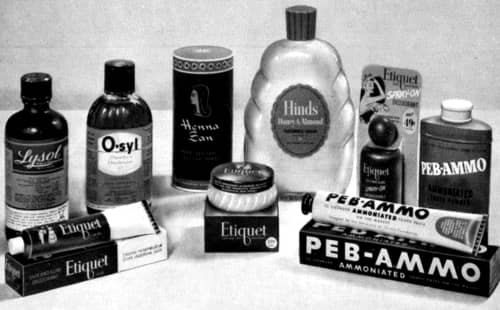
Above: 1951 Products from the Lehn & Fink group.
Television: Although many American cosmetic companies had expressed an interest in advertising on television before 1950, investment in the medium accelerated after 1951 when Hazel Bishop used it to achieve astonishing sales for its indelible lipsticks.
See also: Hazel Bishop
Lehn & Fink had been advertising on television for some time but, in 1954, the company decided to increase its television advertising budget and sponsor The Ray Bolger Show on ABC-TV. Unfortunately, the increased sales generated by television fell well short of the rise in the advertising budget and this produced a dramatic drop in the company’s net earnings.
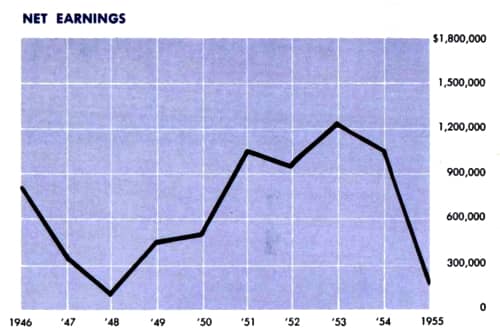
Above: Lehn & Fink Net Earnings 1946-1955
This failure did not put the company off television and management remained committed to the medium.
Redirection
The poor results of 1955 triggered a major review at Lehn & Fink and by 1956 the company had developed a new five-year plan. Growth was to be produced through the development of new products, cutting costs by improving operational efficiency and through the acquisition new lines of business. In the 1950s, many American cosmetic companies diversified into pharmaceuticals but Lehn & Fink chose domestic and industrial cleaning products, an area in which the company had some experience.
In 1957, Lehn & Fink bought National Laboratories, Inc. based in Toledo, Ohio. National made cleaning products, most notably: N-L Concentrate, a liquid cleanser; Vani-Sol Bowl Cleanse, a toilet cleanser; and Dura-Text Concentrate Floor Finish. In 1958, the National Laboratories division would develop Duel, an aerosol household disinfectant and deodoriser. This led to the development of Lysol Spray, an aerosol disinfectant-deodoriser, released nationally in 1962. It was a great success and by 1968 it held over 40% of its category in the American market.
Other acquisitions included the Hallemite Manufacturing Company of Cleveland (1964); the U.S. Sanitary Specialties Company of Chicago (1964), a supplier of bulk disinfectants to hospitals and Beacon (1965), the makers of Beacon Floor Wax.
Young Look
As well as branching into domestic and industrial cleaning products, Lehn & Fink tried its hand in an area dominated by Avon; the door-to-door sale of cosmetics. Beginning around 1958, it developed a new range of cosmetics and hired representatives to sell it. The new line was called Young Look and, as its name suggests, it was aimed at a younger market. Young Look contained a limited range of make-up consisting of lipsticks (Shades: Pink, Flame Red, True Red, Fuchsia and Really Orange), Compact Make-Up and Velvet Film Liquid Foundation (Shades: Fair, Rose Blend, Medium Blend, Coppertone), and a Liquid Rouge (Shades: Hint-O-Red, and Neutral Tone Red).
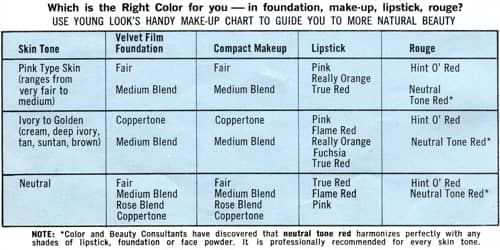
Above: Young Look Make-Up Chart.
Skin-care in the Young Look line was equally limited, being restricted to a Cleansing Lotion, an All-Purpose Cream, and a Hand and Body Lotion.
Also see the company booklet: Introducing Young Look
As others also found, selling cosmetics door-to-door was a more difficult market than might first appear and the line appears to have been abandoned within a few years.
In 1964, Lehn & Fink underwent a major structural change, reorganising its various parts into three main groups:
1. Consumer Products containing Lehn & Fink Products, Dorothy Gray and Tussy;
2. Industrial Products consisting of National Laboratories, Lehn & Fink Professional Division, U.S. Sanitary Specialties and Hallemite; and
3. International Products.
This change reflected the decreasing importance of cosmetics to Lehn & Fink, but the company made an effort to expand the sales of its cosmetics, perfumes and toiletries both within the United States and internationally.
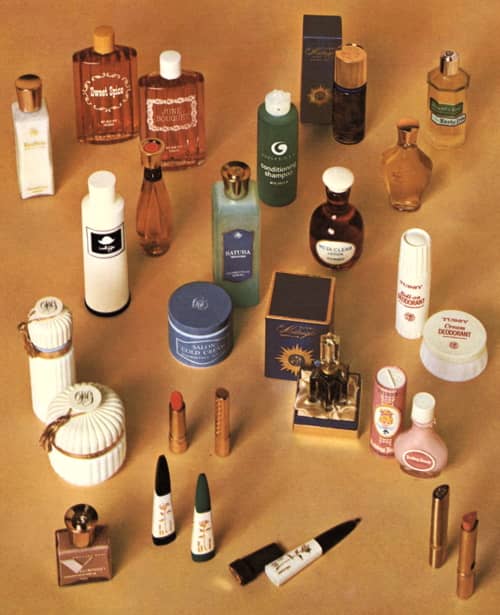
Above: 1965 Lehn & Fink cosmetics from Tussy (Lesquendieu) and Dorothy Gray.
However, there was also some rationalisation. In 1964, Etiquet deodorants and Henna-San were sold off and, in 1965, Dorothy Gray, Tussy (Lesquendieu) and The Ogilvie Sisters were unified into a single business. The following year Lehn & Fink was bought by Sterling Drug, a U.S. pharmaceutical company. Unfortunately, becoming part of a large pharmaceutical firm did not improve the fortunes of Lehn & Fink’s cosmetic interests.
Timeline
| 1874 | Lehn & Fink founded at 160 William Street, New York. |
| 1884 | Lehn & Fink moves to 128 William Street, New York. |
| 1886 | Louis Lehn retires. Albert Plaut becomes a partner. |
| 1890 | Lehn & Fink imports Lysol from Schülke & Mayr, Hamburg, Germany. |
| 1894 | Lehn & Fink imports the first anti-toxin for diphtheria into the United States from Germany. |
| 1898 | Frederick Fink sells his stake in Lehn & Fink to Albert and Joseph Plaut and retires. |
| 1901 | Lehn & Fink moves to 120 William Street, New York. |
| 1910 | Lehn & Fink becomes a company. |
| 1913 | Lehn & Fink becomes the U.S. agents of the Crown Perfumery Co., London. |
| 1916 | Lehn & Fink incorporates. |
| 1918 | Additions made to the factory at 83 Sedgwick Street, New York. |
| 1919 | Lehn & Fink acquires Schülke & Mayr, Hamburg. |
| 1920 | Lysol, Inc. established in New York. New York offices and warehouse moved to 635 Greenwich Street; new factory built at 192 Bloomfield Avenue, Bloomfield, New Jersey. |
| 1924 | Pebeco, Inc. created in New York. |
| 1925 | Lehn & Fink Products Company created as public company; then buys Lehn & Fink, Inc. and A. S. Hinds Co. (Portland, Maine). |
| 1926 | Lehn & Fink purchases Lysol Ltd. (London). |
| 1927 | Lehn & Fink buys Dorothy Gray (New York). |
| 1928 | Executive offices of Lehn & Fink moved to the Dorothy Gray building at 683 Fifth Avenue, New York. |
| 1929 | Lehn & Fink acquires Lesquendieu, Inc. The potency of Lysol increased. |
| 1931 | New Products: Formula L-F Lysol. |
| 1936 | Lehn & Fink Products Company acquires Pebeco, Inc. and the A. S. Hinds Company, which were then dissolved. Lehn & Fink Products Company and Lehn & Fink, Inc. merge into Lysol Inc., which was then renamed the Lehn & Fink Products Corporation. |
| 1942 | New Products: Etiquet Cream Deodorant. |
| 1944 | New factory opened in Argentina. |
| 1945 | Lehn & Fink Products Corporation acquires Lysol Ltd. (London); Schülke & Mayr; and the worldwide rights for Lysol. |
| 1947 | New factory leased in Lincoln, Illinois. Executive offices moved to 445 Park Avenue, New York. |
| 1948 | New Products: O-Syl and Amphyl professional disinfectants. |
| 1949 | Etiquet Deodorant repackaged. New Products: Peb-Ammo Tooth Paste and Powder. |
| 1950 | New Products: Etiquet Spray-on Deodorant. |
| 1952 | Lysol repackaged. New Products: Non-poisonous Lysol. |
| 1953 | New factory built in Rio de Janeiro, Brazil. |
| 1956 | Lysol repackaged. Lehn & Fink Products Corporation buys The Olgivie Sisters. |
| 1957 | Lehn & Fink Products Corporation acquires National Laboratories, Inc. New eastern shipping centre opened in Clifton, New Jersey. New Products: Etiquet Rolit deodorant. |
| 1958 | Lehn & Fink Products Corporation purchases the United Whelan Corporation, a chain store. New Products: Pine-Scented Lysol; and Duel an aerosol disinfectant deodorant. |
| 1959 | New Products: Lysette, a liquid douche; and Medi-Quik Spray, a first-aid aerosol. |
| 1960 | Lehn & Fink Products Corporation acquires Noreen, Inc. |
| 1962 | New Products: Lysol spray disinfectant-deodoriser; and Titan insecticide. |
| 1964 | Bloomfield plant sold. Lehn & Fink Products Corporation reorganised into Consumer, Industrial and International Products. |
| 1964 | New factory in Glashütte, West Germany. Etiquet and Henna-San lines sold. |
| 1965 | Dorothy Gray, Tussy and The Ogilvie Sisters organised into the one business. |
| 1966 | Lehn & Fink Products Corporation bought by Sterling Drug, Inc. |
Updated: 16th July 2020
Sources
An agency plans new TV campaign. (1954). Broadcasting Telecasting, September 27, 85-88.
The chemist and druggist. (1859-). London: Morgan Brothers.
Editorial Note. (1913). California State Journal of Medicine, XI(4) April, 135.
Farrell, H. C. (1949). Lehn & Fink’s diamond jubilee. Drug and Cosmetic Industry, 46(6), June, 685-686, 779-781.
Lehn & Fink. Annual Reports 1925-1964.
Murray, G. M. (Ed.). (1924). Fifty years. Commemorating the fiftieth anniversary of the founding of Lehn & Fink, Inc. New York: Lehn & Fink.
The national cyclopedia of American biography. (1939). Volume XXVII. New York: James T. White & Company.
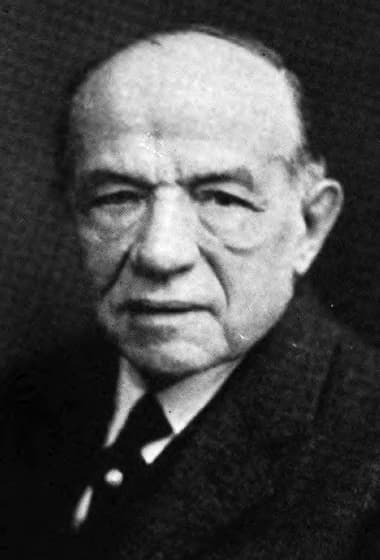
Frederick William Fink [1846-1925]. Frederick married Minnie Spengeman in 1872 and the couple had three children: Carrie Elizabeth, Colin Garfield and Statts Louis Fink (The national cyclopedia of American biography, 1939, p. 456).
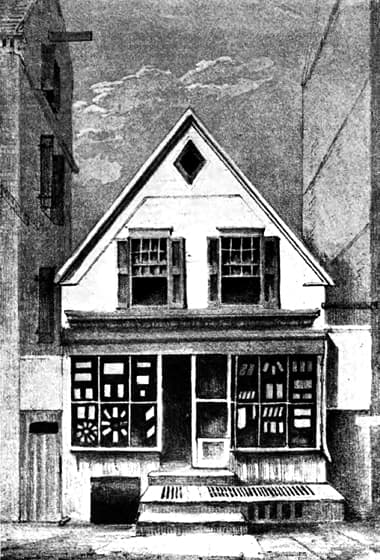
A drawing of the original building at 160 William Street, Manhattan.
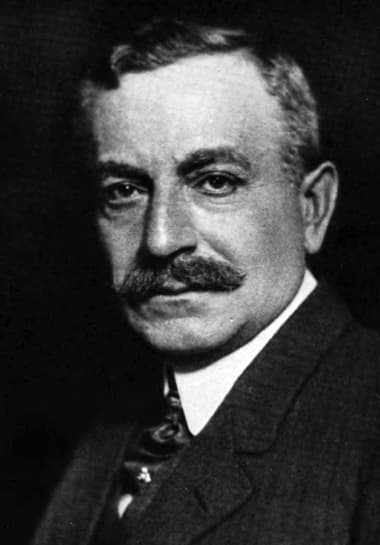
Albert Plaut [1857-1915] joined Lehn & Fink in 1879 as a stock clerk but soon transferred to the general business office before becoming a partner.
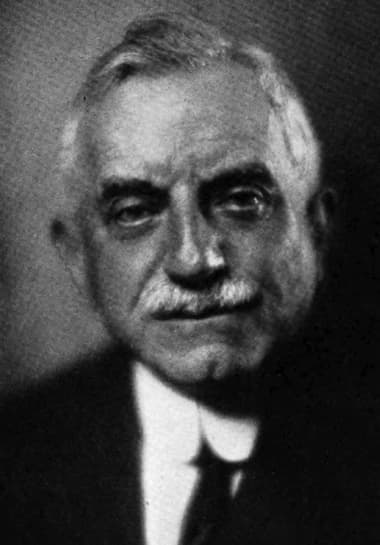
Joseph Plaut [1858-1949]. He became Lehn & Fink’s financial manager.
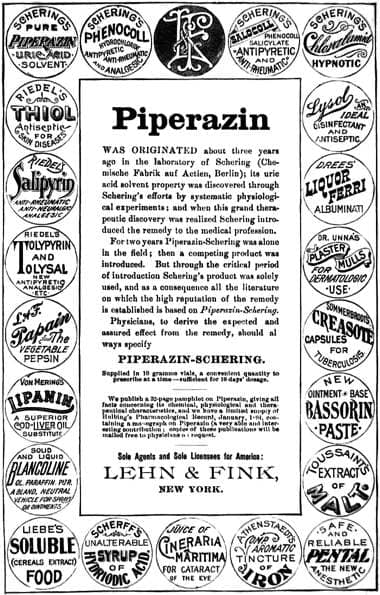
1894 Products distributed by Lehn & Fink.
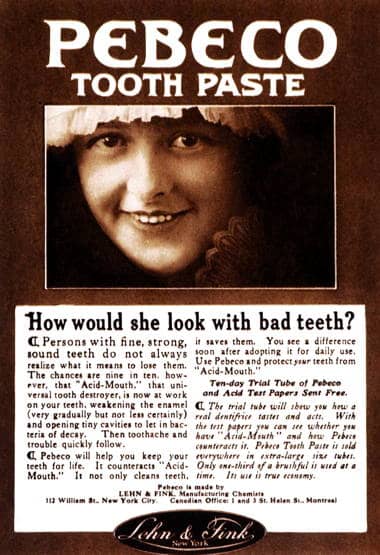
1916 Pebeco Tooth Paste. The original formulation included potassium chlorate.
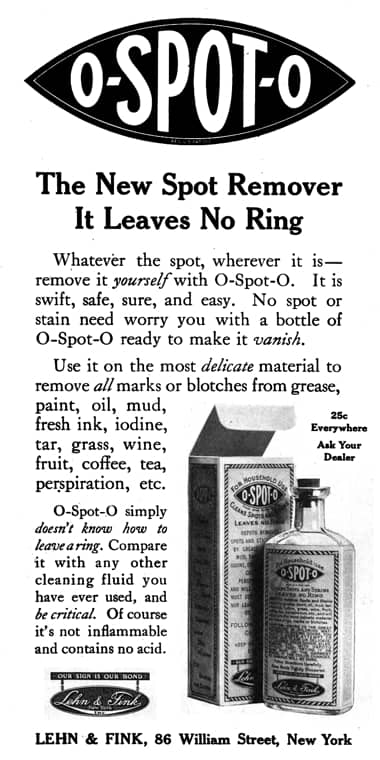
1917 O-Spot-O Cleaner.
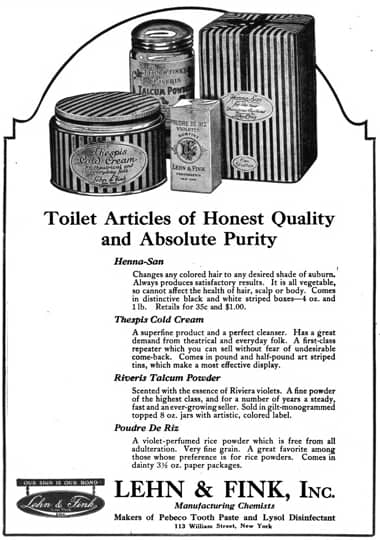
1919 Lehn & Fink Henna-San, Thespis Cold Cream, Riveris Talcum Powder and Poudre De Riz.
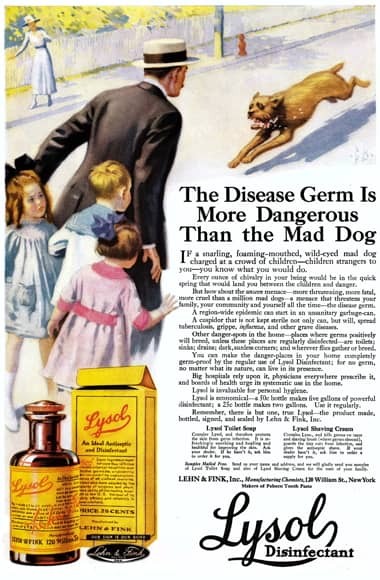
1919 Lysol.
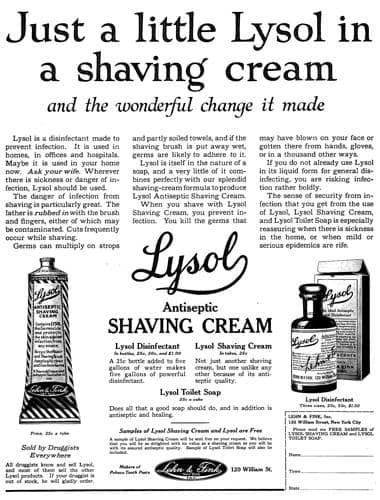
1919 Lysol Antiseptic Shaving Cream.
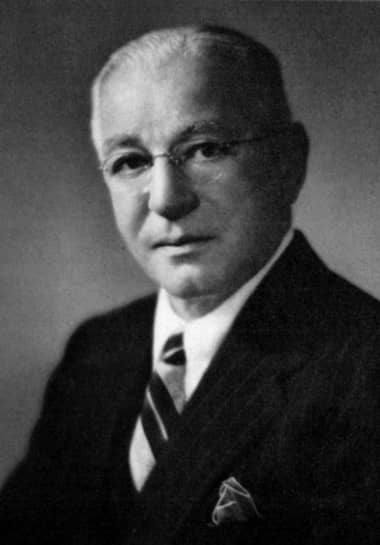
Edward Plaut [1891-1972]. He joined the firm with a Ph.D. in Chemistry so remained interested in product research long after he became president of the company in 1921.
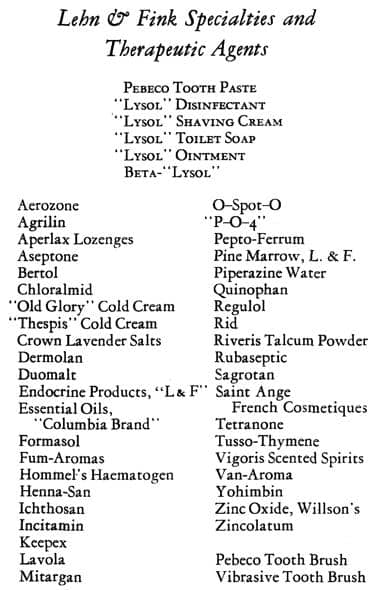
1924 Lehn & Fink Product List.
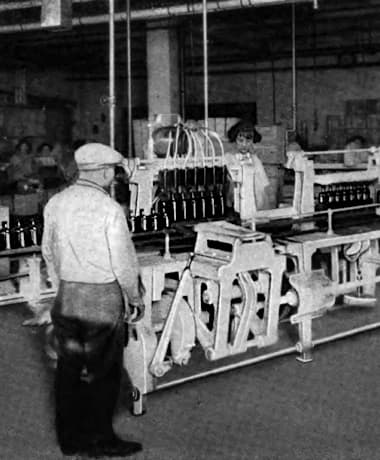
1924 Filling bottles of Lysol at the Bloomfield plant.
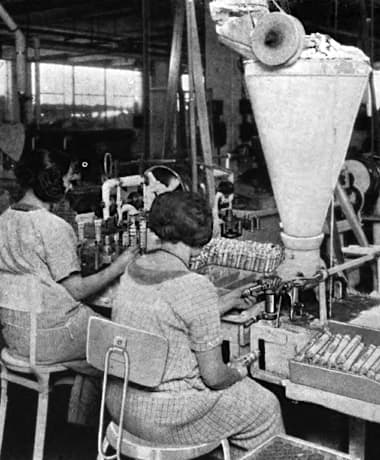
1924 Filling tubes of Pebeco at the Bloomfield plant.
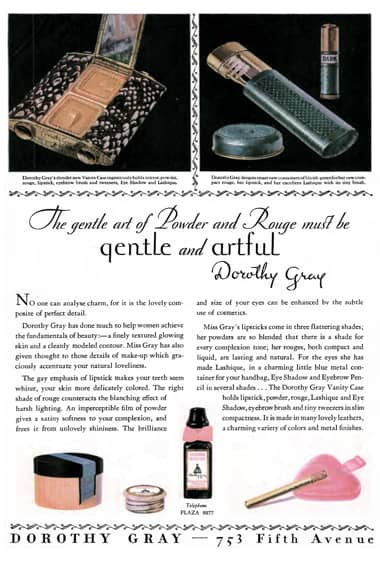
1928 Dorothy Gray. Lehn & Fink bought the business in 1927.
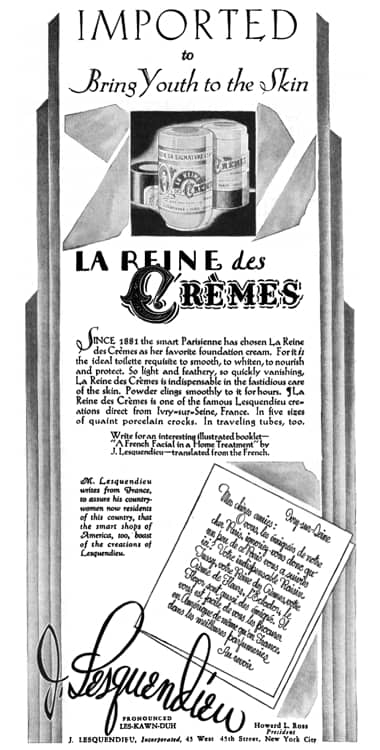
1928 Lesquendieu. Lehn & Fink acquired the company in 1929.
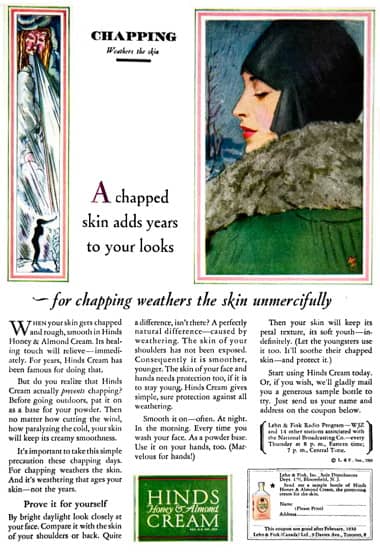
1929 Hinds Honey & Almond Cream. Lehn & Fink had bought the firm back in 1925.
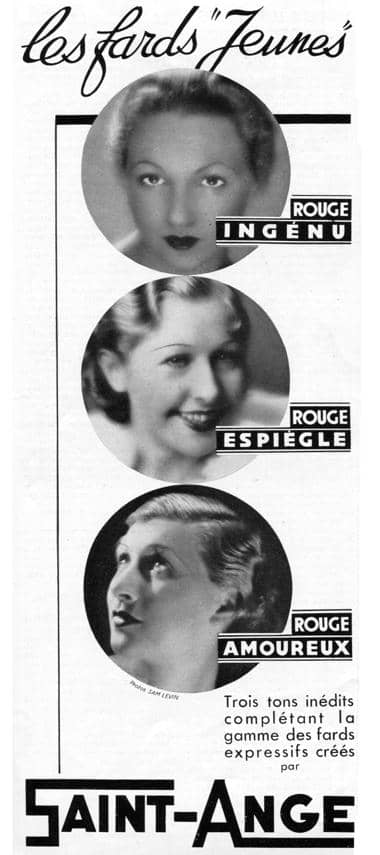
1935 Saint Ange Cosmetiques. Lehn & Fink were acting as distributors for these French cosmetics in 1924 but may have stopped doing so after they acquired Dorothy Gray in 1927.
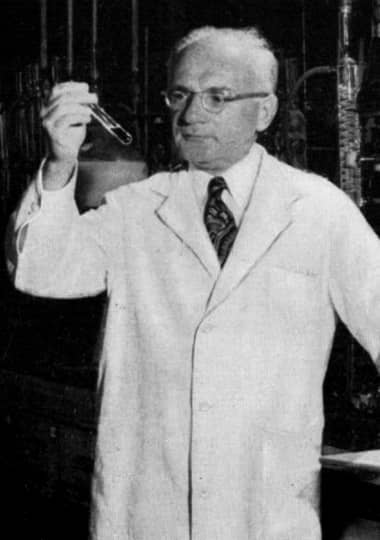
Dr. Emil G. Klarmann [1900-1963]. Born in Austria, he attended the Technological Institute of Bruenn (Brno University of Technology, Czech Republic) and the University of Halle (Martin Luther University of Halle-Wittenberg, Germany) before coming to the United States in 1924 to continue his research at the Rockefeller Institute in New York. He become Lehn & Fink’s Chief Chemist in 1926 and became their head of technical services in 1953.
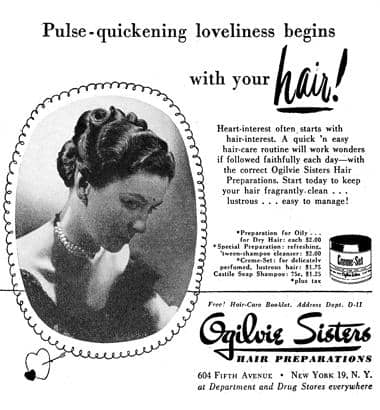
1946 The Ogilvie Sisters. Purchased by Lehn & Fink in 1956.
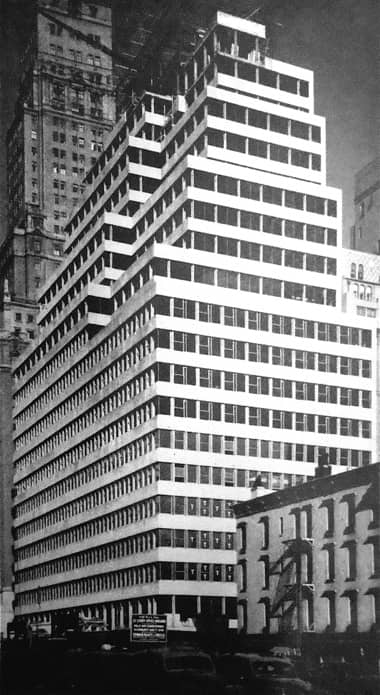
Universal Pictures Building at 445 Park Avenue, New York. Completed in 1947 (Kahn & Jacobs architects). Lehn & Fink occupied the 12th and 13th floors of the 22 storey building. They also leased additional salon and retail space for Dorothy Gray.
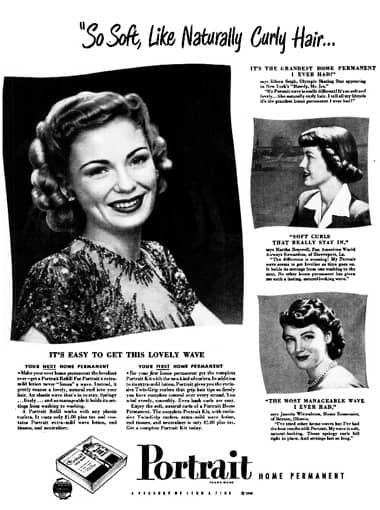
1948 Portrait Home Permanent the year it was acquired by Lehn & Fink.
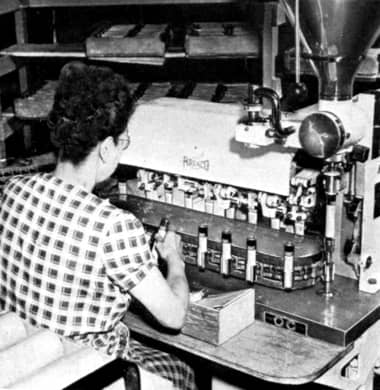
1949 Filling and sealing Pebeco Toothpaste tubes at the Lehn & Fink factory in Bloomfield, New Jersey.
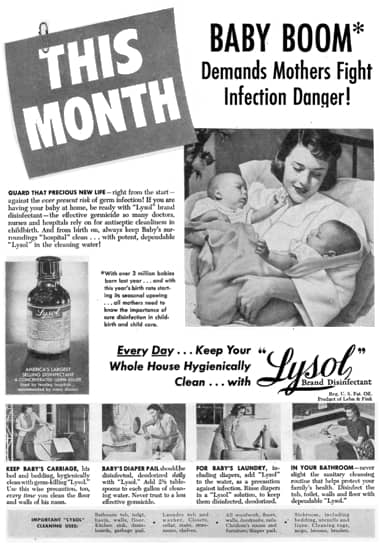
1949 Lysol capitalising on the post-war baby boom.
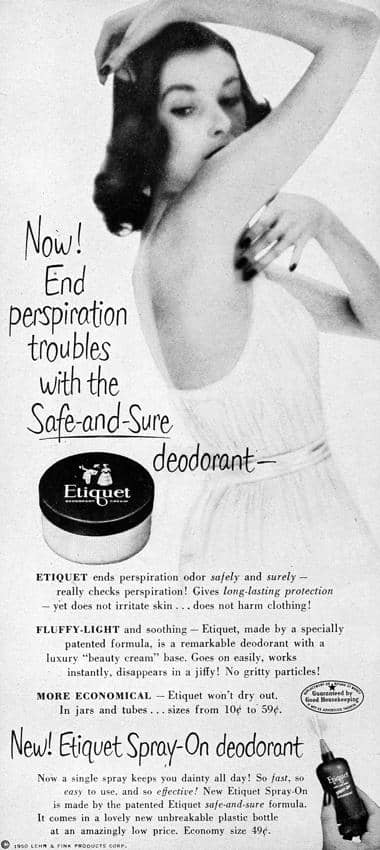
1950 Etiquet Cream Deodorant in new packaging and Etiquet Spray Deodorant.
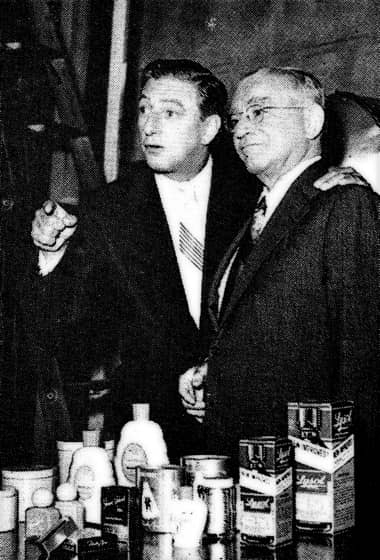
1954 Ray Bolger [1904-1987] and Edward Plaut on the set of ‘The Ray Bolger’ show. Assorted Lehn & Fink products are displayed on the table.
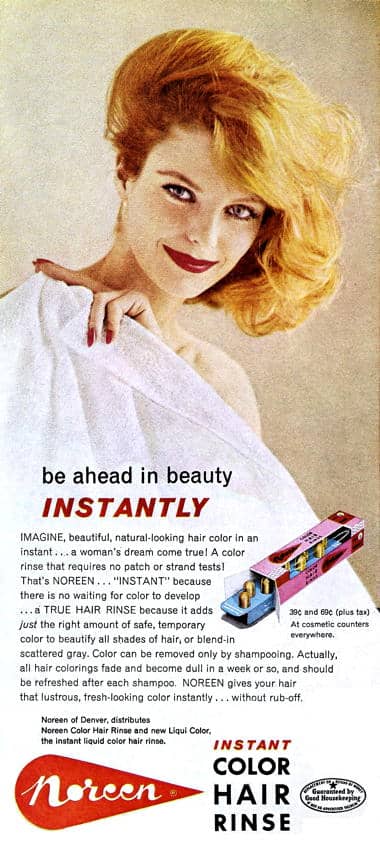
1960 Noreen Instant Color Hair Rinse as purchased by Lehn & Fink.
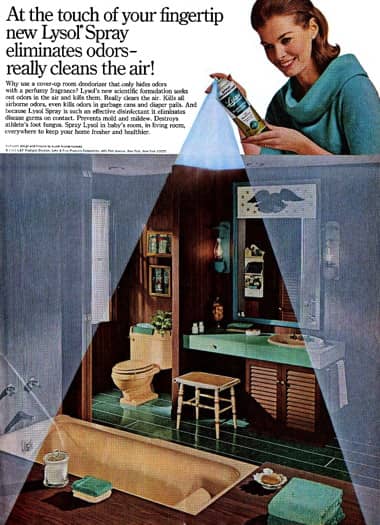
1965 Lysol Spray room deodoriser and disinfectant. First introduced in 1962.
